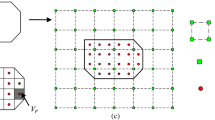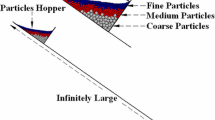Abstract
To understand the entrainment process in granular flow, numerical experiments have been conducted using a Discrete Element Method model. A flow channel of 8 m long with \(15^\circ \) slope is setup with monitoring points located in an erodible bed. Particles, ranging from 3 to 4 mm in diameters, are used in the simulations. In the simulations, translational, rotational and average velocities, total volume, shear stresses are calculated in the measurement circles. The sizes of the measurement circles have been varied to see their effects on the results. It is found the minimum size of the measurement circles should include 20–30 particles. An new analytical model has been developed to calculate entrainment in granular flow. Results of the numerical experiment are compared with analytical model. Shear stresses at the interface between flowing particles in motion and the immobile particles in the channel bed, change of depth of erosion and entrainment rate are used to verify the analytical model. It is found that the calculated shear stresses in the PFC model agree well with the shear stresses calculated using Mohr–Coulomb frictional relationship in the analytical model. The calculated depth of erosion using the new analytical model is also compared with that from dynamic and static entrainment model. The results indicates that the analytical model is able to capture the mechanism of erosion and it can be used in granular flow analysis.












Similar content being viewed by others
References
Albaba, A., Lambert, S., Nicot, F., Chareyre, B.: Relation between microstructure and loading applied by a granular flow to a rigid wall using DEM modeling. Granul. Matter 17(5), 603–616 (2015)
Banton, J., Villard, P., Jongmans, D., Scavia, C.: Two-dimensional discrete element models of debris avalanches: parameterization and the reproducibility of experimental results. J. Geophys. Res. 114, F04013 (2009). https://doi.org/10.1029/2008JF001161
Berger, C., McArdell, B.W., Schlunegger, F.: Direct measurement of channel erosion by debris flows, Illgraben, Switzerland. J. Geophys. Res. Earth Surf. 116(F01002) (2011). https://doi.org/10.1029/2010JF001722
Bishop, A.W.: Correspondence. Géotechnique 4(1), 43–45 (1954)
Bouchut, F., Ionescu, I.R., Mangeney, A.: An analytic approach for the evolution of the static/flowing interface in viscoplastic granular flows. Commun. Math. Sci. 14(8), 2101–2126 (2016)
Caquot, A.: Equilibre des Massifs a’ Frottement Interne. Stabilite des Terres Pulv6rents et Coherentes. Gauthier Villars, Paris (1934)
Cheng, N.S., Law, A.W.K., Lim, S.Y.: Probability distribution of bed particle instability. Adv. Water Resour. 26(4), 427–433 (2003)
Chigira, M.: Dry debris flow of pyroclastic fall deposits triggered by the 1978 Izu-Oshima-Kinkai earthquake: the “collapsing” landslide at Nanamawari, Mitaka-Iriya, southern Izu Peninsula. Nat. Disaster Sci. 4(2), 1–32 (1982)
Chou, S.H., Lu, L.S., Hsiau, S.S.: DEM simulation of oblique shocks in gravity-driven granular flows with wedge obstacles. Granul. Matter 14(6), 719–732 (2012)
Crosta, G.B., Imposimato, S., Roddeman, D.: Granular flows on erodible and non erodible inclines. Granul. Matter 17(5), 667–685 (2015)
Cundall, P.A.: A computer model for simulating progressive, large scale movements in blocky rock systems. In: Proceedings of the International Symposium on Rock Mechanics, Editors: Anonymous, Nancy, France, October 4–6, 1971, vol. 2, pp. 129–136. Rubrecht, Germany (1971)
Cundall, P.A., Strack, O.D.: A discrete numerical model for granular assemblies. Géotechnique 29(1), 47–65 (1979)
Egashira, S., Honda, N., Itoh, T.: Experimental study on the entrainment of bed material into debris flow. Phys. Chem. Earth Part C Sol. Terr. Planet. Sci. 26(9), 645–650 (2001)
Fenton, J.D., Abbott, J.E.: Initial movement of grains on a stream bed: the effect of relative protrusion. Proc. R. Soc. Lond. Ser. A Math. Phys. Eng. Sci. 352(1671), 523–537 (1977)
He, J.M., Li, X., Li, S.D., Yin, Y.P., Qian, H.T.: Study of seismic response of colluvium accumulation slope by particle flow code. Granul. Matter 12(5), 483–490 (2010)
Higashitani, K., Iimura, K., Harota, M., Suzuki, M., Watanabe, S.: Simulation of entrainment of agglomerates from plate surfaces by shear flows. Chem. Eng.Sci. 64(7), 1455–1461 (2009)
Hungr, O., Evans, S.G.: Entrainment of debris in rock avalanches: an analysis of a long run-out mechanism. Geol. Soc. Am. Bull. 116(9–10), 1240–1252 (2004)
Hungr, O., Leroueil, S., Picarelli, L.: The Varnes classification of landslide types, an update. Landslides 11(2), 167–194 (2014)
Hutter, K., Koch, T., Plüss, C., Savage, S.B.: The dynamics of avalanches of granular-materials from initiation to runout. 2. Experiments. Acta Mech. 109(1–4), 127–165 (1995)
Itasca, Consulting Group Inc., PFC2D Particle Flow Code in 2 Dimensions. User’s Guide (2002)
Iverson, R.M., Logan, M., LaHusen, R.G., Berti, M.: The perfect debris flow? Aggregated results from 28 large-scale experiments. J. Geophys. Res. Earth Surf. 115(F03005), (2010). https://doi.org/10.1029/2009JF001514
Iverson, R.M., Reid, M.E., Logan, M., LaHusen, R.G., Godt, J.W., Griswold, J.P.: Positive feedback and momentum growth during debris-flow entrainment of wet bed sediment. Nat. Geosci. 4(2), 116–121 (2011)
Iverson, R.M.: Elementary theory of bed-sediment entrainment by debris flows and avalanches. J. Geophys. Res. 117(F03006) (2012). https://doi.org/10.1029/2011JF002189
Iverson, R.M., Ouyang, C.: Entrainment of bed material by Earth-surface mass flows: review and reformulation of depth-integrated theory. Rev. Geophys. 53(1), 27–58 (2015)
Kang, C., Chan, D., Su, F., Cui, P.: Runout and entrainment analysis of an extremely large rock avalanche—a case study of Yigong, Tibet, China. Landslides 14(1), 123–139 (2017)
Kang, C., Chan, D.: Modelling of entrainment in debris flow analysis for dry granular material. Int. J. Geomech. (ASCE) 17, 04017087 (2017)
Li, W.C., Li, H.J., Dai, F.C., Lee, L.M.: Discrete element modeling of a rainfall-induced flowslide. Eng. Geol. Eng. Geol. 149, 22–34 (2012)
Li, X.P., He, S.M., Luo, Y., Wu, Y.: Discrete element modeling of debris avalanche impact on retaining walls. J. Mt. Sci. 7(3), 276–281 (2010)
Lin, J., Wu, W.: A general rotation averaging method for granular materials. Granul. Matter 19(3), 44 (2017)
Luna, B.Q., Remaitre, A., van Asch, T.W.J., Malet, J.P., van Westen, C.J.: Analysis of debris flow behavior with a one dimensional run-out model incorporating entrainment. Eng. Geol. 128, 63–75 (2012)
Mangeney, A., Roche, O., Hungr, O., Mangold, N., Faccanoni, G., Lucas, A.: Erosion and mobility in granular collapse over sloping beds. J. Geophys. Res. 115(F03040) (2010). https://doi.org/10.1029/2009JF001462
McCoy, S.W., Kean, J.W., Coe, J.A., Staley, D.M., Wasklewicz, T.A., Tucker, G.E.: Evolution of a natural debris flow: in situ measurements of flow dynamics, video imagery, and terrestrial laser scanning. Geology 38(8), 735–738 (2010)
McCoy, S.W., Kean, J.W., Coe, J.A., Tucker, G.E., Staley, D.M., Wasklewicz, T.A.: Sediment entrainment by debris flows: in situ measurements from the headwaters of a steep catchment. J. Geophys. Res. Earth Surf. 117(F03016) (2012). https://doi.org/10.1029/2011JF002278
McCoy, S.W., Tucker, G.E., Kean, J.W., Coe, J.A.: Field measurement of basal forces generated by erosive debris flows. J. Geophys. Res. Earth Surf. 118(2), 589–602 (2013). https://doi.org/10.1002/jgrf.20041
McDougall, S., Hungr, O.: A model for the analysis of rapid landslide motion across three-dimensional terrain. Can. Geotech. J. 41(6), 1084–1097 (2004)
Medina, V.H., Bateman, A., Hurlimann, M.: A 2D finite volume model for bebris flow and its application to events occurred in the Eastern Pyrenees. Int. J. Sediment Res. 23(4), 348–360 (2008)
Melosh, H.J.: Acoustic fluidization: can sound waves explain why dry rock debris appears to flow like a fluid in some energetic geologic events? Am. Sci. 71(2), 158–165 (1983)
Montserrat, S., Tamburrino, A., Roche, O., Niño, Y., Ihle, C.F.: Enhanced run-out of dam-break granular flows caused by initial fluidization and initial material expansion. Granul. Matter 18(1), 1–9 (2016)
Okada, Y., Ochiai, H.: Coupling pore-water pressure with distinct element method and steady state strengths in numerical triaxial compression tests under undrained conditions. Landslides 4(4), 357–369 (2007)
Potyondy, D.O., Cundall, P.A.: A bonded-particle model for rock. Int. J. Rock Mech. Min. Sci. 41(8), 1329–1364 (2004)
Reid, M.E., Iverson, R.M., Logan, M.A.T.T.H.E.W., LaHusen, R.G., Godt, J.W., Griswold, J.P.: Entrainment of bed sediment by debris flows:results from large-scale experiments. In: Genevois R., Hamilton, D.L., Prestininzi, A. (eds.) Proceedings of Fifth International Conference on Debris-flow Hazards Mitigation, Mechanics, Prediction and Assessment, Casa Editrice Universita La Sapienza, Rome, June 14–17, 2011, pp. 367–374 (2011)
Remaître, A., van Asch, ThWJ, Malet, J.P., Maquaire, O.: Influence of check dams on debris-flow run-out intensity. Nat. Hazards Earth Syst. Sci. 8(6), 1403–1416 (2008)
Remaître, A., Malet, J.P, Maquaire, O.: Sediment budget and morphology of the 2003 Faucon debris flow (South French Alps): scouring and channel-shaping processes. In: Malet J.P., Remaitre A., and Bogaard T. (eds.) Proceedings of the International Conference on Landslide Processes: From géomorphologie Mapping to Dynamic Modelling, Strasbourg, France, February 6–7, 2009, pp. 75–80. CERG, Strasbourg (2009)
Salciarini, D., Tamagnini, C., Conversini, P.: Discrete element modeling of debris-avalanche impact on earthfill barriers. Phys. Chem. Earth 35(3), 172–181 (2010)
Savage, S.B., Hutter, K.: The dynamics of avalanches of antigranulocytes materials from initiation to runout analysis. Acta Mech. 86, 201–223 (1991)
Shodja, H.M., Nezami, E.G.: A micromechanical study of rolling and sliding contacts in assemblies of oval granules. Int. J. Numer. Anal. Methods Geomech. 27(5), 403–424 (2003)
Skempton, A.W.: The pore-pressure coefficients A and B. Geotechnique 4(4), 143–147 (1954)
Wu, F.C., Chou, Y.J.: Rolling and lifting probabilities for sediment entrainment. J. Hydraul. Eng. 129(2), 110–119 (2003)
Xu, Q., Shang, Y.J., van Asch, ThWJ, Wang, S.T., Zhang, Z.Y., Dong, X.J.: Observations from the large, rapid Yigong rock slide-debris avalanche, southeast Tibet. Can. Geotech. J. 49(5), 589–606 (2012)
Zhou, G.G., Ng, C.W.: Numerical investigation of reverse segregation in debris flows by DEM. Granul. Matter 12(5), 507–516 (2010)
Acknowledgements
This study is sponsored by the Natural Science and Engineering of Canada Discovery Grant.
Author information
Authors and Affiliations
Corresponding author
Ethics declarations
Conflict of interest
We declare that we have no financial and personal relationships with other people or organizations that can inappropriately influence our work, there is no professional or other personal interest of any nature or kind in any product, service and/or company that could be construed as influencing the position presented in, or the review of, the manuscript entitled.
Rights and permissions
About this article
Cite this article
Kang, C., Chan, D. Numerical simulation of 2D granular flow entrainment using DEM. Granular Matter 20, 13 (2018). https://doi.org/10.1007/s10035-017-0782-x
Received:
Published:
DOI: https://doi.org/10.1007/s10035-017-0782-x




